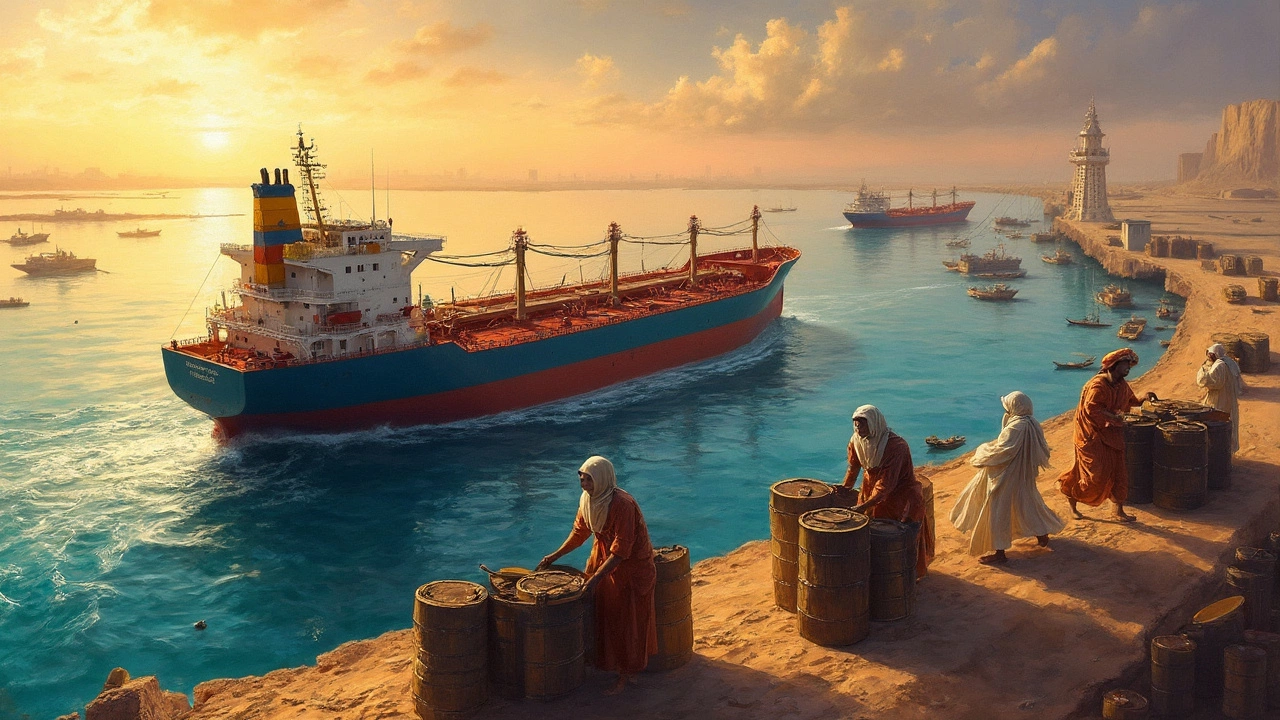
International trade is more than just exchanging goods between countries; it's the lifeline of many economies, including India's. If you're considering taking up trade courses, knowing how these exchanges tick is a must.
Ever thought about your smartphone's origin? Chances are, it's a product of international trade. India's tech relationship with the US is a prime example. From software services to hardware components, this exchange defines much of our tech landscape.
Then there's oil. Did you know a significant chunk of India's oil comes from the Middle East? For anyone diving into trade studies, understanding this energy exchange is crucial because it influences everything from economics to politics.
- Tech Industry Trade Between India and the US
- Oil Imports from the Middle East
- Textile Exports to Europe
- Agricultural Products from Brazil
Tech Industry Trade Between India and the US
The tech trade between India and the US isn't just business; it's the backbone of our gadgets and software. Both countries are major players in the tech game, making this exchange crucial for both economies. India's IT services industry is a global powerhouse, supplying tech solutions that underpin many American companies' operations.
According to NASSCOM, Indian IT exports to the US account for about 50% of the total market. This collaboration is not only a testament to the trust and dependency but also to innovation. An impressive development is how India has become a hub for research and development, pushing boundaries in tech advancements. Why does this matter? If you're studying trade, recognizing these patterns is vital for future opportunities.
What's motivating this tech trade? For one, the cost-effective and skilled workforce in India is a huge draw for US companies. As Infosys CEO Salil Parekh said,
"The partnership between India and the US in technology demonstrates the power of combining innovation with scale."
Key Tech Products And Services In Trade
- Software Development: India's strength in software solutions is legendary, with companies like TCS and Wipro at the forefront.
- IT Support: Much of the US's IT infrastructure gets support from Indian tech firms, ensuring round-the-clock stability and innovation.
- Hardware Components: While software is big, don't forget the trade of essential hardware parts, supporting a global supply chain.
The significance is clear: International trade in tech sets the stage for economic growth, innovation, and job creation across borders. For students considering trade courses in India, understanding the dynamics of the tech trade with the US can provide a competitive edge.
Oil Imports from the Middle East
Oil imports are a big deal for India, especially when it comes to the Middle East. This region supplies a huge portion of India’s crude oil, making it a vital partner in the international trade arena. If you're diving into trade courses in India, understanding this oil exchange is crucial.
Why the Middle East? It's simple. The Middle East has abundant oil reserves, and they’ve been trading with India for decades. Countries like Saudi Arabia and Iraq are consistently among the top oil suppliers to India. As of late 2023, these two countries alone accounted for over 30% of India's oil imports.
Impact on Economy and Energy Security
These imports aren't just about filling up gas stations. They play a crucial role in powering India's growing economy. Industries like transportation and manufacturing heavily rely on these oil imports. Plus, they keep electricity costs in check since many power plants run on petroleum products.
Focusing on energy security, this trade has a wide-reaching impact on India's overall stability. Profitable relations with the Middle East ensure that India can cope with fluctuations in global oil prices. For trade enthusiasts, observing how geopolitical tensions or diplomatic relationships affect oil prices can be particularly enlightening.
The Role of Crude Oil Prices
Oil prices are like a roller coaster—always up and down. Anyone interested in trade needs to monitor these fluctuations, which can significantly affect global financial markets and consumer prices at home. By analyzing trends and predictions, you can better understand how oil prices shape international trade dynamics.
The importance of oil trade with the Middle East can't be overstated. It's the backbone of energy imports, feeding India’s growth and fueling the dreams of future traders looking to get a slice of the global market. If you're eyeing a career in trade, this is one relationship to watch closely.

Textile Exports to Europe
India’s textile industry is a powerhouse in the global market, especially when it comes to exports to Europe. If you’re enrolled or considering trade courses in India, this is a sector worth paying attention to.
Why, you ask? Well, India's known for its high-quality cotton and diverse textile offerings. These include everything from traditional garments to contemporary fabric designs, many of which end up in European markets. The sheer diversity satisfies Europe's varied fashion tastes.
Cotton: The Cornerstone
Did you know India is one of the largest producers of cotton? This natural fiber has a sturdy place in the textile trade with Europe. Strong demand for Indian cotton has been driven by its reputed quality, which makes it a staple in many European clothing lines.
Don't underestimate the role of organic cotton either. As European consumers become more eco-conscious, demand for sustainable textiles has skyrocketed, making organic cotton a hot commodity.
Synthetic Textiles
It's not just about cotton. India is also a major player in synthetic textiles like polyester. These materials are popular in Europe for their durability and easy maintenance, finding use in everything from sportswear to winter gear.
Challenges and Opportunities
International trade isn't without its hurdles. Trade policies, tariffs, and compliance with strict European standards can complicate things. Yet, these challenges also offer avenues for innovation and growth. Trade courses often emphasize learning to navigate these hurdles effectively.
For example, by leveraging modern tech like AI and blockchain, India’s textile industry is improving traceability and reducing operational costs, thereby appealing even more to European partners.
Here's a quick snapshot of key data:
| Year | Textile Export Value (in billion USD) |
|---|---|
| 2021 | 36 |
| 2022 | 40 |
| 2023 | 43 |
This ongoing upward trend is exciting for anyone stepping into the realm of international trade, particularly in India. Whether it’s understanding quality standards or eco-labels, there’s much to learn that could set you apart in the trade industry.
Agricultural Products from Brazil
When you think about international trade, Brazil might not be the first country that comes to mind, but it's a global giant, especially in agriculture. Brazil's vast land and diverse climate make it ideal for producing a variety of crops, and these play a crucial role in trade with India.
Let's talk about soybeans. Brazil is the top exporter of soybeans in the world, and India is a significant importer. Soybeans are vital for producing animal feed, which in turn supports India's poultry and dairy industries. This makes the soybean trade between these two countries a textbook example of how global markets work.
Another major player is coffee. Brazil is famous for its coffee exports, leading with both quantity and quality. While traditionally a tea-drinking nation, India's urban areas are seeing a surge in coffee consumption, driven by younger demographics and changing lifestyles. This offers an interesting opportunity for expanding trade dynamics between these two nations.
Sugar and Orange Juice: Sweet Trades
Sugar, another star in Brazil's export portfolio, finds its way into the Indian market. Given that India itself is a large sugar producer, the trade primarily balances out market demands and production cycles, showcasing the complex nature of international trade relationships.
And don't forget about orange juice. Brazil leads in orange juice exports globally. Although not a staple in India yet, the growing fascination with health drinks presents a promising niche market, a fact worth noting for anyone interested in trade courses.
In essence, trade courses that focus on agricultural trading can greatly benefit from the Brazil-India connection. It provides a real-world backdrop against which students can learn about logistics, market demands, and global cooperation.
